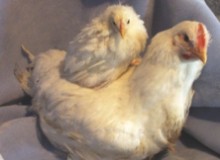Poultry research leads to breakthrough in genetic studies

A Virginia Tech animal scientist, who in 1957 began breeding lines of White Plymouth Rock chickens based on their juvenile body weight, has provided a model for exploring the molecular basis of traits like growth and reproduction, which molded the red jungle fowl into a farm animal about 8,000 years ago.
Paul Siegel, University Distinguished Professor Emeritus of Animal and Poultry Sciences in the College of Agriculture and Life Sciences, co-authored an article in the 25 March issue of the scientific journal Nature that uses data from his decades-long poultry selection project. The article, Whole-genome resequencing reveals loci under selection during chicken domestication, highlights research at Uppsala University in Sweden and the Broad Institute of MIT and Harvard University.
“Throughout my career, I have been interested in studying the relationships between growth, reproduction, and immunology of chickens,” said Siegel, who joined the Virginia Tech faculty in 1957.
In his first month on the job, Siegel designed an experiment that would create 2 flocks of a common breed of chickens: a high-growth line and a low-growth line. Every year he bred the heaviest and lightest chickens with others of similar weight. Today, Siegel’s high-growth chickens are 9 times larger than the low-growth ones by the time they reach selection age, even though they both originated from the same flock.
“By selecting for growth, we are testing the genetic and immunological limits of poultry,” Siegel explained.
In 2004, scientists completed the genome sequence of the red jungle fowl – the same species as the domestic chicken. Researchers throughout the world began to search for genetic markers that determine specific traits in broilers, layers, and red jungle fowl. This research has led to factors that have affected the chicken genome through domestication.
In addition to scanning the genetic information of common breeds of poultry, researchers looked at the extreme cases of the high- and low-growth chickens at Virginia Tech. According to Siegel, the decades of poultry breeding complete the recent advances in genome sequencing technology.
“The question becomes, ‘Now that we have the technology, do we have the populations to support the use of the technology?’” Siegel said. “The answer is ‘yes’. Not only do we at Virginia Tech have a population, we have the complete pedigree for 53 generations.”
The research team identified a gene found in all of Virginia Tech’s high-growth chickens but few of the low-growth ones that appears to regulate appetite – a finding that could have ramifications for both animal and human health studies involving weight. Previous research has shown that appetite, in addition to metabolism, plays a significant role in weight gain or loss in poultry.
The team is also investigating a gene that encodes the thyroid-stimulating hormone receptor protein to determine whether domestication altered the genetic makeup of chickens thousands of years ago. If true, this would be the first time that scientists have identified a mutation in animals caused by domestication.
Source: Virginia Tech













